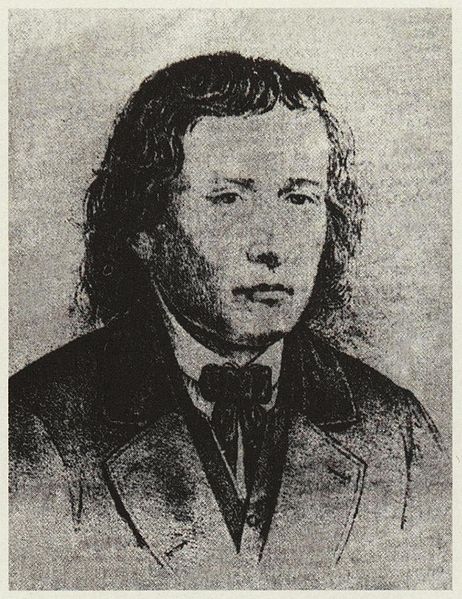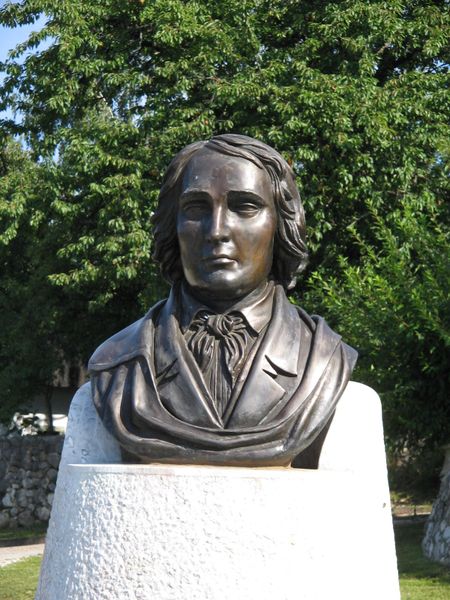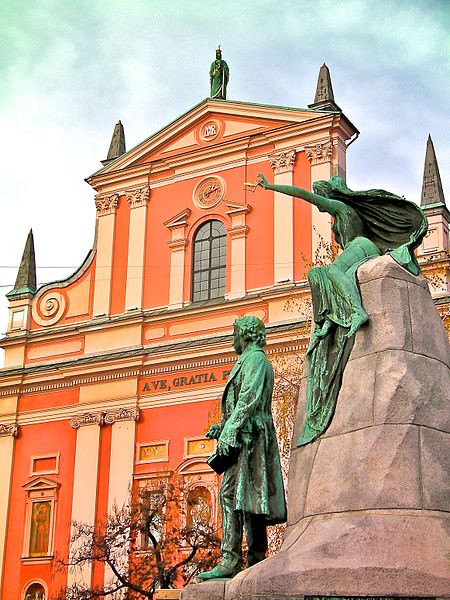<Back to Index>
- Philosopher and Writer Hryhorii Savych Skovoroda, 1722
- Poet France Prešeren, 1800
- Prime Minister of Japan Prince Higashikuni Naruhiko, 1887
PAGE SPONSOR



France Prešeren (3 December 1800 – 8 February 1849) was a Slovene Romantic poet. He is considered the Slovene national poet. Although he was not a particularly prolific author, he inspired virtually all Slovene literature thereafter.
He was born 3 December 1800 in the Upper Carniolan village of Vrba, then part of the Habsburg Monarchy (today in Slovenia), to a relatively well - to - do peasant family. Already as a child, he showed considerable talent, so his parents decided to provide him with a good education. At the age of eight, he was sent to elementary schools in Grosuplje and Ribnica, run by the local Roman Catholic clergy. In 1812, he moved to the Carniolan provincial capital of Ljubljana, where he attended the State Gymnasium. Already at a very young age, he learned Latin, Ancient Greek, as well as German, which was then the language of education, administration and high culture in most areas inhabited by Slovenes. In Ljubljana, Prešeren's talent was spotted by the poet Valentin Vodnik who encouraged him to develop his literary skills in the Slovene language. As a high school student, he became friends with the future philologist Matija Čop, who would have an extremely important influence on the development of Prešeren's poetry. In 1821, Prešeren enrolled at the University of Vienna, where he studied law, against the wishes of his mother who wanted him to become a priest. In Vienna, he became acquainted with the western canon from Homer to Goethe, but he was most fascinated by Dante and the Italian trecentists, especially Petrarch and Boccaccio. He also read contemporary Romantic poets, and he was even fired from the teaching post at the Klinkowström's Jesuit institute for having lent a booklet of banned poetry to his friend Anastasius Grün.
After acquiring a law degree in 1828, he returned to Ljubljana, where he got employment as an assistant in the firm of the lawyer Leopold Baumgartner. He was constantly striving to become an independent lawyer by putting in as many as six applications, but he was not successful. In 1832, he shortly moved to Klagenfurt in the hope of furthering his career, but returned to Ljubljana after less than a year. In the spring of 1833, he met Julija Primic, the daughter of a rich merchant, who would become the unfulfilled love of his life. In 1834, he began working as an assistant to his friend Blaž Crobath who gave Prešeren enough free time to engage in his literary activities. In the same year, he met the Czech romantic poet Karel Hynek Mácha and the Slovene born Croatian poet Stanko Vraz and had long and fruitful discussions on poetry with them.
Around 1836, Prešeren finally realized that his love for Julija would never become mutual. The same year, he met Ana Jelovšek, with whom he entered into a permanent relationship. They had three children, but never married. Prešeren supported Ana financially and treated her as his rightful mate, but engaged in several other love affairs at the same time. He also spent a lot of time travelling throughout Carniola, especially to Lake Bled, from the scenery of which he drew inspiration for his poems. In 1846, Prešeren was finally allowed to open his own law firm and moved to Kranj with his family. He died there on 8 February 1849. Upon his deathbed he confessed that he had never forgotten Julija.
In
general, Prešeren's life was an unhappy one. He was confronted with
constant rejections, had an unstable sentimental life, and saw most of
his closest friends die tragically. He lived in confrontation with both
the civil and religious establishment, as well as with the provincial
bourgeoisie of Ljubljana. His talent was far too high to be fully
acknowledged by the contemporary culturally backward society of
Slovenia. He fell victim to severe drinking problems and tried to take his life on at least two occasions. The motive of "the hostile fortune" is a frequent one in his works. Prešeren's
first serious poetic attempts date from his student years in Vienna. In
1824, he wrote some of his most popular poems, still under the
influence of Valentin Vodnik and
the rich tradition of Slovenian folk poetry. In 1825, he completed a
collection of "Carniolan songs", which he showed to the philologist Jernej Kopitar.
Kopitar was very critical of the young man's literary attempts, so
Prešeren destroyed the whole collection. Kopitar's rejection hindered
the development of Prešeren's creativity; he did not publish anything
more until 1827, when his satirical poem "To the Maidens" (Dekletom) was published by the German language journal Illyrisches Blatt. In 1828, Prešeren wrote his first important poem, A Farewell to Youth. It was however published only in 1830, in the literary journal Kranjska č'belica ("The Carniolan Bee"), established the same year by the publisher Miha Kastelic in Ljubljana. In
1830, Prešeren's old high school friend Matija Čop returned to
Ljubljana and re-established contacts with Prešeren. Čop soon
recognized his friend's poetic talent and persuaded him to adopt Romanic poetic forms. Following Čop's advice, Prešeren would soon become a master of the sonnet. His poems were noticed by the Czech scholar František Čelakovský who
published several highly positive critiques of it. Čelakovský's
praise was extremely important for Prešeren's self esteem and gave him
the strength to continue in the path on which Čop had orientated him. Between
1830 and 1835, Prešeren composed his esthetically most accomplished
poems, which were inspired by the setbacks in his personal life,
especially by the unhappy love for Julija Primic. Prešeren followed
Čop's advice and transformed Julija into a poetic figure, reminiscent of Dante's Beatrice and Petrarch's Laura, as can be seen in this first stanza of his poem Gazele: In my heart shall ever proudly reign - your name;
he most important poem from this period is the crown of sonnets Sonetni Venec ("A
Wreath of Sonnets"), written and published in 1834. In it, Prešeren
tied together the motives of his own unhappy love with that of an
unhappy, subjugated homeland. In the seventh sonnet, Prešeren made
something that was later seen as a prophecy of his own glory: referring
to the ancient myth of Orpheus, he invoked the skies to send a new Orpheus to the Slovene people, the
beauty of whose poetry would inspire patriotism, help overcome internal
disputes and unify all Slovenes into one nation again. In the eighth
sonnet, he went on in exposing the reasons why such an Orpheus — the
metaphor for high culture in general and poetry in particular — had not
yet been produced by the Slovenes. Exposing a decidedly negative vision
of Slovenian history,
consisting of nothing but foreign invasions and internal disputes ("the
roar of tempests o'er a home unkind"), he maintained that it was the
lack of glorious deeds that had hindered the flourishing of poetry. The
few flowers of poetry still growing on the Slovenian Parnassus were fed
only by tears and sighs: Such was our land since Samo's rule had passed But,
he went on in the next sonnets, there was still hope for the renewal of
Slovenian poetry and thus for the coming of an Orpheus that would unify
all the nation with his gentle singing: Julija only had to "send rays
from her eyes for their glory to renew". Prešeren's message was clear:
if Julija accepted his advances, she would become the muse inspiring
solemn poems which would bring a new high culture to the Slovenes and
thus make them a nation again. Besides
the complex and sophisticated content, the "Wreath of Sonnets" has an
interesting format, too: the last line of one sonnet becomes the first
line of the next one, making all fourteen sonnets of the circle an
intertwining "garland" of emotional lyricism; one sonnet cannot exist
without the other. The first lines of all the single fourteen sonnets
form in turn another sonnet, called the "Master Theme" or the Magistrale. In the English translation by Vivian de Sola Pinto the Master Theme is as follows: A record of my pain and of your praise, In the Slovene original, however, the first letters of every verse form the words Primicovi Julji,
meaning "to Julija Primic". The poem was recognized as a masterpiece by
Matija Čop, but it did not gain much recognition beyond the small
circle around the Kranjska č'belica magazine. Moreover, Julija was unimpressed. Understandably, Prešeren moved to more bitter verses.
Another important work from this period are the "Sonnets of Unhappiness" (Sonetje nesreče),
which were first drafted already in 1832, but were published only in
1834, with some changes. They are undoubtedly the most pessimistic of
Prešeren's works. It is a group of six (initially seven) sonnets
expressing the poet's despair over life. The first sonnet,
in which Prešeren debates about what his life could have been like had
he never left his home village, became extremely popular during the
late 19th century. In the 20th century, several musical interpretations
of the poem were created, the most known a version by the Slovene folk rock musician Vlado Kreslin.
The other sonnets from the circle have not gained such a widespread
popularity, but are still considered by scholars to be among Prešeren's
most genuine and profound works. 1835 was Prešeren's annus horibilis. His closest friend Matija Čop drowned while swimming in the Sava river, Julija Primic married a wealthy merchant, and Prešeren became alienated from his friend and editor of the Kranjska č'belica literary magazine Miha Kastelic. Following Čop's death, Prešeren wrote his magnum opus, The Baptism at the Savica Waterfall (Krst pri Savici), dedicating it to his late friend. The poem, set during the Christianisation of Karantanians in the late 8th century, addresses the issues of hope, faith and resignation. The philosopher Slavoj Žižek interpreted the poem as a paradigmatic example of the emergence of modern subjectivity. In 1837, Prešeren met Emil Korytko, a Polish political activist from Galicia, confined by the Austrian authorities to Ljubljana. Korytko introduced to Prešeren the work of Adam Mickiewicz, which had an important influence on his later works. The two even jointly translated one of Mickiewicz's poems (Resygnacja) from Polish to Slovenian and started collecting Slovenian folk songs in Carniola and Lower Styria. In 1839, Korytko died, leaving Prešeren without an important interlocutor after Čop's death. In the autumn of the same year, Andrej Smole,
one of Prešeren's friends from his youth, returned home after many
years of living and travelling abroad. Smole was a relatively rich
young intellectual from a well established merchant family, who
supported the development of Slovenian culture. The two spent much of
the winter of 1839 - 1840 on Smole's estate in Lower Carniola,
where they planned several cultural and literary projects, including
the establishment of a daily newspaper in the Slovenian language and
the publishing of Anton Tomaž Linhart's comedy "Matiček's Wedding" which had been prohibited as "politically inappropriate" in 1790, due to the outbreak of the French Revolution. Both projects failed: the planned journal Ilirske novice was
blocked by the Viennese censorship, and Linhart's play would be staged
only in 1848, without Prešeren's assistance. Smole died suddenly in
1840, literally in Prešeren's arms, while celebrating his 40th
birthday. Prešeren dedicated a touching, yet unexpectedly cheerful and vitalist poem to his late friend. After
1840, Prešeren was left without any interlocutor who could appreciate
his works, but continued to write poetry, although much less than in
the 1830s. He gradually departed from the typical romantic trend,
adopting an increasingly diverse and innovative style. In 1843, an
important breakthrough for Prešeren happened: Janez Bleiweis started
publishing a new daily journal in the Slovenian language and invited
Prešeren to participate in its cultural section. The two men came from
rather different backgrounds: Bleiweis was a moderate conservative and
staunch supporter of the ecclesiastical and imperial establishments and
alien to the Romantic culture. He nevertheless established a fair
relationship with the poet. Prešeren's participation in Bleiweis'
editorial project was the closest he would come to public recognition
during his lifetime. In 1844, he wrote the patriotic poem Zdravljica ("A
Toast"), the most important achievement of his late period. In 1847, a
volume of his collected poems was published under the simple title Poezije dr. Franceta Prešerna ("Poems of Dr. France Prešeren"). Prešeren
spent the last two years of his life occupied with private life and his
new job as a lawyer in Kranj. According to some accounts, he was
planning several literary projects, including a novel in the realistic style and an experimental play, but he was struck with liver disease caused by his excessive drinking in prior years. The revolution of 1848 left him rather indifferent, although it was carried out by the young generation who already saw him as an idol of democratic and national ideals. Before his death, he did however redact his Zdravljica, which was left out from the 1847 volume of poems, and made some minor adjustments for a new edition of his collected poems. Today,
Prešeren is still considered one of the leading poets of Slovenian
literature, acclaimed not only nationally or regionally, but also
according to the standards of developed European literature. Prešeren
was one of the greatest European Romanticists. His fervent, heartfelt
lyrics, intensely emotional but never merely sentimental, have made him
the chief representative of the Romantic school in Slovenia. Nevertheless,
recognition came slow after his death. It was not before 1866 that a
real breakthrough in the reception of his role in Slovenian culture
took place. In that year, Josip Jurčič and Josip Stritar published
a new edition of Prešeren's collection of poems. In the preface,
Stritar published an essay which is still considered one of the most
influential essays in Slovenian history. In it, he showed the aesthetic
value of Prešeren's work by placing him in the wider European context.
From then on, his reputation as the greatest poet in Slovene language
was never endangered. Prešeren's legacy in Slovenian culture is enormous. He is generally regarded as the national poet. In 1905, his monument was placed in the central square in Ljubljana, now called Prešeren Square.
By the early 1920s, all his surviving work had been catalogued and
numerous critical editions of his works had been published. Several
scholars were already dealing exclusively with the analysis of his work
and little was left unknown about his life. In 1944, the anniversary of
his death, called Prešeren Day, was declared as the Slovenian Cultural Holiday. In 1990, the seventh stanza of his Zdravljica was declared the national anthem of Slovenia, replacing the old Naprej zastava slave. In 1992, his effigy was portrayed on the Slovenian 1000 tolar banknote, and since 2007 his image is on the Slovenian two - euro coin. The highest Slovenian prize for artistic achievements, the Prešeren Award, is named after him. His
poems have been translated into several languages, although he still
lacks the recognition accorded to some other poets of his rank.
Let my countrymen hear echoes, east and west,
Of the music in that joyous strain - your name;
On this shrine shall nations henceforth read your fame;
Here it stays to glow and glow again - your name.
When both you and I have crossed in Charon's boat,
Even then the glory will remain - your name.
More than Cynthia, Laura, Delia and Corrina,
Time will ever hallow my refrain - your name.
With Samo's spirit - now an icy blast
Sweeps o'er his grave reft from the nation's mind.
Our fathers' bickerings let Pepin bind
His yoke upon us, then came thick and fast
Bloodstained revolts and wars, the Turk at last -
With woes our history is deeply lined.
Our age of glory needs must disappear
When deeds of valour ceased in our past state
And triumphs that our songs could celebrate.
The flowers on our Parnassus shyly rear
Their heads - the flowers that have been spared by fate:
They were all fed on many a plaint and tear.
Since from my heart's deep roots have sprung these lays,
These tear - stained flowers of a poet's mind.
They come from where no man can sunshine find,
Unblest by soothing winds of warmer days;
Above them savage peaks the mountains raise,
Where tempests roar and nature is unkind.
They were all fed on many a plaint and tear;
Frail growth these blossoms had, so sad and few,
As over them Malignant storm-clouds flew.
Behold how weak and faded they appear!
Send but your rays their glory to renew -
Fresh flowers will spread fragrance far and near.